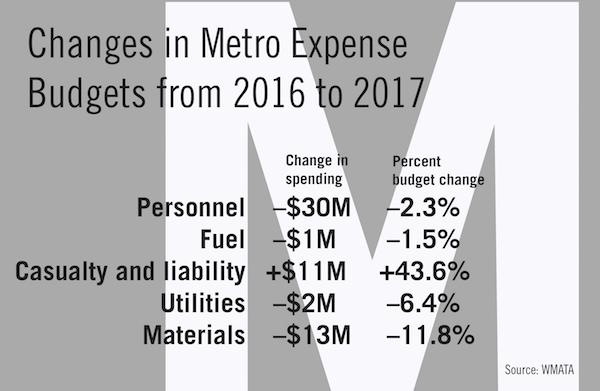The Washington Metropolitan Area Transit Authority is cutting funds for long-term improvements and taking a step back to find ways to make spending more efficient.
WMATA’s board of directors approved the Metro’s $1.74 billion budget for the next fiscal year earlier this month, cutting its long-term improvements budget by $150 million and its operating budget by about $15 million. The board decided not to allocate funds for specific improvements until it decides what spending would be the most necessary investments, a Metro spokesman said.
The Metro’s new budget slices funding across areas like salaries, fuel and utilities, while putting more money toward insurance and expected lawsuit fees. This spending on insurance and claims will increase by more than $10 million – a 43 percent increase from the previous fiscal year.
The board approved a $30 million cut – a 2 percent drop – to the personnel category of the budget, which includes employee salaries.
Metro spokesman Dan Stessel said in an email that the personnel cuts will come from not hiring new employees, though there is also natural turnover in staff ranks as employees quit or retire. He said the decline in expenses will also come from making the system more efficient overall.
“The most important thing for you to know is that the budget fully funds safety and reliability programs, and there are no fare increases or service cuts,” Stessel said.
Tom Lipinsky, a spokesman for D.C. Council member Jack Evans, said the board allocated funds in October to hire consultants that will identify how to use the system’s resources in better ways. Evans is Foggy Bottom’s Council member and the chair of the Metro’s Board of Directors.
The six-month study will cost the system about $2.8 million, according to a press release. Lipinsky said the board anticipates the consultants will find about $20 million in unnecessary spending at the completion of the study.
“This year is really going to be about laying a strong foundation to make the necessary safety and reliability investments that are going to make the Metro a stronger system for riders and a stronger organization moving forward,” Lipinsky said.
In 2012, Congress cut federal funding for Metro by $15 million, leaving less funding for maintenance projects such as repairing tracks and escalators.
Metro ridership has declined by almost 5 percent in all stations in the past five years, according to Metro ridership data through the end of the 2015 fiscal year. The budget attributes the decline to “a number of external challenges, including growth in telecommuting and new competitors in the transportation market.”
“It’s trying to find inexpensive but effective solutions to the problems that we know we have now,” Lipinsky said.
The report shows that the Metro will try to address the customer service issues by implementing a free bus pass, adding a period of time to reimburse any fare fees after entering and leaving the same station within a 15-minute time span, removing the ability to add value to a card on Metrobus and working with universities to create discounted student passes.
This past month, students supported a plan in a Student Association election referendum that involves students paying a $250 fee on top of their tuition for discounted Metro rides during the academic year.
“We hope students will find it beneficial, and I think it is part of this new Metro in trying to be more proactive and more flexible,” Lipinsky said.
Earlier this month, Metro shut down for more than a day in order to have staff inspect more than 600 jumper cables following fires along lines. The shutdown cost the Metro $2 million.
The budget also includes money to add bright yellow decals at the Metro Center, Gallery Place, L’Enfant Plaza and Union Station stops, which were installed recently. The board put in these new markers to increase platform safety and reduce congestion by showing customers where they should stand to wait for the train.








